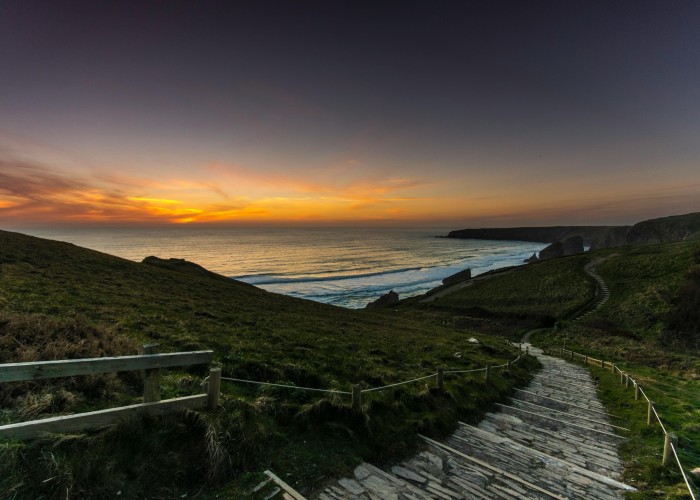The South West Coast Path is England’s longest waymarked long-distance footpath, stretching about 630 miles (1,014 kilometers) along the stunning coastline of southwest England. It runs through four counties—Somerset, Devon, Cornwall, and Dorset—offering walkers a unique blend of dramatic cliffs, sandy beaches, quaint fishing villages, and breathtaking countryside. South West Coast Path Walk – England.
This path is famous for its varied landscapes and rich wildlife. It attracts walkers, nature lovers, and adventure seekers from across the globe, including visitors from the USA, UK, Australia, and Germany. The trail is not only a physical challenge but also a cultural journey, with historic landmarks, charming towns, and local traditions along the route.
Best Time to Visit
The best months to walk the South West Coast Path are late spring through early autumn—specifically May to September.
- Spring (April-May): Wildflowers bloom and the weather begins to warm. Fewer crowds make it ideal for a peaceful walk.
- Summer (June-August): Warmest weather and vibrant seaside towns, but it can get busy. Booking accommodations early is advisable.
- Autumn (September): Cooler temperatures and fewer walkers. The coastline’s autumn colors make for a scenic experience.
Winter is generally not recommended due to shorter daylight hours, unpredictable weather, and potential trail closures.
How to Reach the South West Coast Path
- By Air: The closest major airports include Exeter International Airport and Bristol Airport. London airports (Heathrow, Gatwick) are also options with onward train or bus travel.
- By Train: The South West Coast Path is well-served by trains with key stations including Exeter, Plymouth, Truro, and Penzance. The UK rail network connects these stations to major cities like London and Bristol.
- By Road: Renting a car or using bus services is common for accessing trailheads and towns along the path. Many parking options exist near popular sections.
The path’s length allows for flexible entry and exit points depending on your preferred section.
Entry Fees and Permits
There are no entry fees or permits required to walk the South West Coast Path. The trail is public and free to access year-round.
However, some nature reserves or historic sites along the route may charge small entrance fees. Accommodations, campsites, and certain attractions might have costs, but the walking itself remains free.
Food Availability and Meal Options
The South West Coast Path passes through numerous towns and villages, so food and drink options are plentiful.
- Pubs and cafes: Enjoy traditional English fare such as fish and chips, Cornish pasties, and cream teas.
- Local markets and shops: Stock up on fresh produce, snacks, and picnic supplies.
- Self-catering: Many accommodations offer kitchen facilities, perfect for preparing your own meals.
- Packed lunches: Carrying sandwiches, fruits, and energy bars is a practical option for long walking days.
Seafood is a highlight in coastal towns, reflecting the region’s fishing heritage.
Packing List and Essentials
To make the most of your South West Coast Path walk, pack thoughtfully:
- Comfortable hiking boots with good grip
- Weather-appropriate clothing (layers, waterproof jacket)
- Hat and sunscreen for sun protection
- Backpack with water bottles and snacks
- Map or guidebook of the path
- Mobile phone with charger and power bank
- First aid kit including blister treatment
- Lightweight sleeping bag or liner if camping
- Trekking poles (optional but helpful for rough terrain)
- Identification and cash/cards for purchases
Safety Tips and Local Regulations
- Stay on marked paths to protect wildlife and avoid dangerous cliff edges.
- Inform someone of your planned route and expected arrival times.
- Check weather forecasts regularly; coastal weather can change rapidly.
- Carry enough water, especially in summer months.
- Respect private property; some sections cross farmland.
- Follow local regulations, including dog control and fire safety rules.
- Take care when walking on slippery or uneven surfaces. South West Coast Path Walk – England.
Tips for Beginners or First-Time Visitors
- Plan your route in manageable sections rather than attempting the entire path at once.
- Build up walking stamina through shorter hikes before the trip.
- Book accommodations in advance during peak season.
- Use guidebooks or apps designed for the South West Coast Path for navigation.
- Pack light to reduce fatigue.
- Start early in the day to maximize daylight hours.
- Take rest days to recover and explore local towns. South West Coast Path Walk – England.
Local Customs and Cultural Etiquette
- Greet locals politely; many walkers exchange friendly “hello” or “good morning.”
- Respect local traditions, including quiet hours in villages.
- Avoid littering—carry out what you carry in.
- Support local businesses by purchasing food or souvenirs.
- Be mindful when photographing people and private property.
Frequently Asked Questions (FAQs)
How long does it take to walk the South West Coast Path?
Walking the entire path can take 6 to 12 weeks depending on pace and route choices. Many walkers opt for shorter sections lasting a few days to a week.
What is the difficulty level of the path?
The trail is considered moderate to challenging, with some steep climbs and uneven terrain. Basic fitness and proper footwear are important.
Are there restrooms available along the way?
Yes, restrooms can be found in towns, cafes, pubs, and visitor centers. Public toilets are also located at popular trailheads.
Can I walk the path year-round?
Yes, the path is open year-round, but winter months can be harsh and some facilities may close.
Is the path well-marked?
Yes, the South West Coast Path is clearly marked with distinctive acorn symbols and signposts.
Can I bring my dog?
Dogs are welcome on most sections but must be kept under control, especially near livestock.
Are there campsites along the route?
Yes, numerous campsites and caravan parks are available, but booking ahead is recommended in summer. South West Coast Path Walk – England.






Leave a Reply